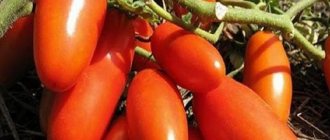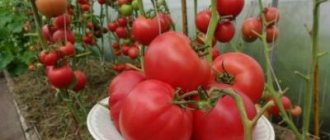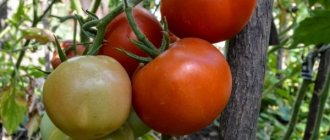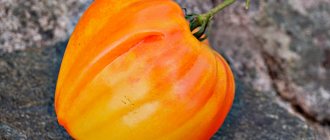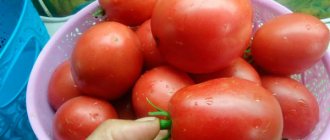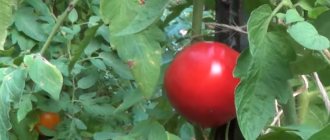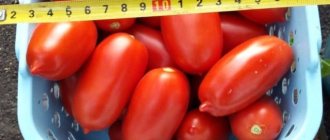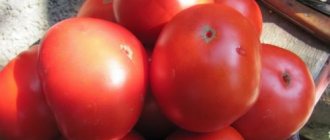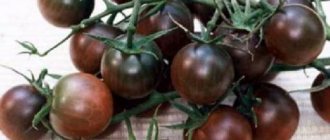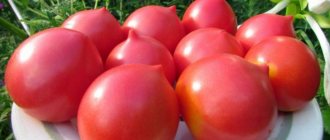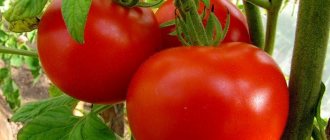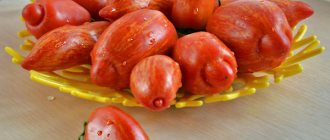History of variety development
This tomato variety was bred by breeders of the Soviet Union in the last quarter of the last century. Due to the compactness of the bushes and good yield, the Dubok tomato was popular among summer residents from different Russian regions almost immediately after its cultivation. The variety was included in the State Register of the country.
In Ukraine and Moldova, as well as in the southern Russian regions, the Dubok (or Dubrava) tomato can be grown in garden beds in open ground. And when grown in areas with a short summer period and the likelihood of a sharp change in temperature, it is advisable to plant this variety in film greenhouses or greenhouse conditions. Many amateur vegetable growers said that Oak bushes grow well and bear fruit even on an apartment window sill or on a glassed-in balcony.
Sowing Dubrava tomatoes directly into the ground
This method is more suitable for the southern regions of the country. Its advantage is that the tomatoes are strong, with more developed roots, they are better resistant to diseases and temperature changes.
Sowing begins in April-early May. The seeds are processed and sown 3 in each hole. When shoots appear, the strongest seedlings are left, the rest are removed.
Description of the tomato variety Dubok
Due to its characteristics, the Dubok tomato is recommended for growing in small farms and private gardens. The main advantage of the variety is the compactness and low growth of the bushes, since the Dubok tomato belongs to the determinate type.
The bushes of this tomato are strong and strong, and are not standard. The shoots are quite powerful, erect, reaching a height of 0.7 m. Since the variety does not branch much and does not form stepchildren, there will be no special hassle in caring for tomatoes.
On a note!
It is recommended to form the Dubok tomato variety into no more than 4 stems.
Successful tomato for open ground: Dubok variety - video
According to the description of the originators of the variety, shoots do not require garter,
however, many summer residents indicate in reviews that without fixation to supports, shoots can fall to the ground under the weight of ripening fruits. As a result, tomatoes may begin to rot if they come into contact with the soil. However, if ripe tomatoes are collected in a timely manner, you can do without tying the stems.
The stems are well leafy, the foliage is elongated, narrow, typically tomato, with slightly wavy edges, slightly wrinkled, dark emerald color.
According to the period of fruit ripening, the Dubok tomato is classified as an early one.
– from the moment the sprouts appear until the first harvest is harvested, it takes about 3 months. The fruiting of this tomato is extended over time and can continue until late autumn.
Photos of tomatoes Dubok
The flowers are collected in racemose inflorescences, each of which can form up to 6 ovaries. The first brushes are formed above the 6th true leaf, and each subsequent one - after 1-2 leaves.
Tomatoes are oval in shape, the skin is dense, medium thickness, smooth, shiny, during ripening it is light green in color; in fully ripe tomatoes it is bright red. Weight of ripe fruits – from 60 to 130 g
. The first ripening fruits are larger, and in the last wave of the harvest the tomatoes are smaller. The fruits are not prone to cracking.
INTERESTING!
Yield varieties of tomatoes for open ground
The pulp is compacted, somewhat dry, inside there are 3 seed chambers with an average amount of seed material. Seeds can be collected for later cultivation.
Advice!
If the last tomatoes of the Dubok variety do not have time to ripen on the bushes, they can be picked and left to ripen at home. In this case, the tomatoes turn red within several days without losing their elasticity and excellent taste.
The taste of ripe Dubok tomatoes is sour-sweet and pleasant.
Ripe tomatoes can be transported over any distance,
and also store for quite a long time - up to 40-45 days.
Features of cultivation
“Dubok” tomatoes are usually grown using the seedling method. Sowing seeds must be done in the first month of spring.
REFERENCE. Before sowing, the seeds must be treated with a solution of potassium permanganate and then washed with running water. Growth stimulants can be used.
If the air temperature in the room where the containers with seedlings are located is maintained at 18-20 degrees Celsius, then after 5-7 days you will be able to admire the first shoots. When the seedlings acquire two full-fledged leaves, they will need to be picked.
During the growth period, seedlings should be fed twice with complex fertilizers, and this should also be done during picking. A week before planting in the soil, seedlings should begin to be hardened off.
It should be added to the characteristics of “Dubok” tomatoes that the age of seedlings when planted in the ground should be from 55 to 65 days. Typically, planting occurs in April or May, when the likelihood of nighttime temperature drops completely disappears.
REFERENCE. The distance between bushes should be 40 centimeters, and between rows - 60 centimeters.
Tomatoes of this variety are suitable for growing in any region of Russia. It is advisable to form the bush into two stems. As for pinching, it is not a mandatory procedure, but it is still recommended. The same goes for tying.
It is very important to choose the right soil, both for planting seedlings and for adult plants in the greenhouse. An article about types of soil for tomatoes will help you figure this out.
Watering Dubok tomatoes should be done after sunset. They do not require abundant watering, but the soil should not be allowed to dry out. Mulching will help retain moisture and prevent weed growth. To increase productivity, Dubok tomatoes must be regularly fed with fertilizers.
To prepare the fertilizer, you need to mix 50 grams of superphosphate and 250 grams of wood ash, as well as one fifth of manure, in a bucket of clean water. This fertilizer needs to be applied once every twenty days.
Read more about how to fertilize tomatoes correctly and with what:
- Organic and mineral fertilizers.
- TOP best.
- Yeast, iodine, hydrogen peroxide, ammonia, ash, boric acid.
- Fertilizers for seedlings and foliar.
We must not forget about removing weeds and loosening the soil, as well as hilling the plants.
Main characteristics
This tomato variety is resistant to temporary drops in temperature and tolerates short periods of drought, as well as increased soil and air humidity.
But the Dubok tomato has one feature - during the flowering period the air temperature should be 22-24 degrees Celsius; at higher temperatures the flowers are not pollinated.
Photo of tomato bushes Dubok
Harvesting
The fruiting phase of Dubok tomatoes lasts about 2–3 weeks. They go out to the garden early in the morning to collect the harvest. The fruits are collected as they ripen.
If you plan to transport them, then it is necessary to remove the tomatoes at the moment of technical maturity, that is, only when they have turned brown. They are placed in boxes and sent to a room with a temperature of +18–25 ° C and a humidity of 80–85%, where they ripen successfully.
If you do not allow the fruits to fully ripen on the bushes, the yield will be higher, since it will be possible to save nutrients for the ripening of the next tomatoes. The densest, largest and healthiest tomatoes are selected for long-term storage. Fruits can be preserved for a long time at a temperature of +11–13 °C and a humidity of 85–90%.
So, tomatoes of the Dubok variety are distinguished by high yield, frost resistance, resistance to disease, high taste of the fruit, unpretentiousness and excellent transportability. Since the variety is determinate, it does not need tying or pinching.
Advantages and disadvantages
The main advantages of the Dubok tomato variety include:
- compactness and small size of bushes;
- early ripening of tomatoes;
- resistance to low temperatures, short periods of drought, increased humidity;
- in hot weather, oak bushes do not reduce yield, but the size of the fruit may decrease;
- bushes of this tomato grow and bear fruit equally well on heavy soils and on sandstones;
- germination rate of seed material is close to 100%;
- the ability to collect seed material from your own fruits.
The most unique and unusual varieties and hybrids of tomatoes!
Unusual varieties of tomatoes
There are practically no downsides to tomatoes, but it should be remembered that at air temperatures above 24 degrees Celsius, the flowers of this tomato may not be pollinated.
Resistance to diseases and pests
One of the main advantages of Dubrava tomatoes is early fruiting and uniform yield. This way, tomatoes do not fall under the main scourge of outdoor cultivation, which is especially rampant in regions with warm climates - late blight.
Dubok's resistance to other diseases is average. If the lower clusters are placed on unprotected soil, or in rainy summers, rot may develop.
Preventive treatments should be done against pests. In warm climates, if crop rotation is not observed, or if they are planted close to potatoes, it is difficult to grow tomatoes without being affected by the Colorado potato beetle.
Dubok tomatoes: how to properly plant seedlings and transplant them to a permanent place of growth
It is better to grow this tomato variety in seedlings. At the same time, seedlings are planted in garden beds at the age of 2 months, and fruiting of the bushes begins earlier.
Preparing seeds and soil for seedlings
Purchased seed material does not require special pre-sowing preparation, only germination before sowing. But the collected seeds from the garden should first be checked for germination - dipped in a salty solution and selected only those that sink to the bottom. The seeds floating on the surface are thrown away - they are empty inside and will not sprout. But usually the Dubok tomato has a germination rate of seeds, even collected in one’s own garden, above 90%.
Then the Dubok tomato seeds need to be kept in a weak solution of potassium permanganate for disinfection, washed and soaked in a solution of a growth stimulant for germination.
It is better to purchase soil for growing seedlings of this tomato in gardening stores, but you can also prepare it at home if you stock up on the necessary components in the fall:
- turf and leaf soil;
- high peat;
- rotted compost (but you can also use humus);
- coarse river sand.
Before planting the seed material, all these ingredients are mixed; for looseness, rotted sawdust can be added to the soil mixture.
Advice!
To disinfect the resulting nutrient substrate, it is spilled with boiling water or a weak solution of potassium permanganate.
TOMATOES!
Siberian Troika Tomato Katya F1 Tomato Blagovest F1
Growing seedlings
The substrate is laid out in containers, watered, grooves are made at a distance of 2.5 cm from each other with a depth of 1 cm. The germinated seed material is laid out in these grooves, the ground is leveled, watered again with a spray bottle and covered with glass or film on top. Before emergence, the containers are placed in a warm, bright place.
After friendly shoots appear, the glass is removed and the containers are transferred to the windowsill, closer to the light.
During the growing process, seedlings need to be watered regularly and a couple of fertilizers containing nitrogen must be added. And 10-12 days before transplanting the seedlings to the beds, they must be hardened off.
Photo of growing tomato seedlings Dubok
Transplantation to a permanent place
The beds into which the seedlings will be transplanted must be located in a well-lit area; humus and a complex of mineral fertilizers must be added to them.
The distance between adjacent holes in the rows should be at least 0.4 m, and the row spacing should be at least 0.6 m. Tomatoes of this variety cannot be planted closer, otherwise they will grow poorly and the yield will decrease.
Photo of transplanting a tomato to a permanent place
Timing of sowing seeds
For Dubrava tomatoes, the description indicates an extended period for the start of ripening - from 87 to 105 days from the moment of mass shoots. This is due to the fact that tomatoes are intended for open ground, and the climatic conditions in Russia are very different.
The time for sowing Dubrava seeds for seedlings is tied to the weather conditions of the region and forecasts. It is not recommended to plant the crop before the soil warms up to 15°C. The Dubrava tomato variety is moved to a permanent place at the age of 45-50 days.
It should be remembered that the description of Dubok tomatoes is given specifically for the regions recommended for cultivation. When planted in a different climate, the yield and taste of the fruit will be worse.
It makes no sense to indicate the time for sowing Dubrava tomato seeds for closed ground - the variety is not intended for greenhouses. Low-growing bushes with a maximum height of 60 cm will never produce such a harvest as those reaching 1.5-2 m. They will only take up useful space.
And all the same, given the unpretentiousness of the Dubok variety, as stated by the manufacturer, the seeds may not germinate. And it’s not the seeds themselves that matter.
Why might this happen?
- If the seeds have been stored for a long time at low temperatures. Then they seem to “fall asleep” and come out of “hibernation” in half a month, or this may not happen at all
- Acidic soil is also not preferable for Dubrava tomatoes. Still, this variety needs at least neutral soil.
- Large amount of water. If too high a percentage of humidity is complemented by low ambient temperatures, then even with the correct sowing process, the seedlings will rot.
- They may also undergo a process of rotting or slow down in growth and simply at very low temperatures.
- Too much depth when sowing seeds also has negative consequences.
- Dense and very heavy soil.
- The soil has a high salt content.
- The presence of toxic substances in the soil.
- There may be an infection in the soil used for planting, and its presence does not depend on where it was taken from. Even if the soil mixture was purchased in a store, do not forget about the desire of unscrupulous sellers to save money (they can simply pick it up in the forest).
- The seeds themselves may also be infected. Even when purchasing from acquaintances, neighbors, friends, and even more so on the market from private traders, it is necessary to subject the seeds to disinfection.
Therefore, the manufacturer is not to blame in all cases when seeds do not germinate. As you can see, this process is influenced by many factors.
We invite you to familiarize yourself with Industrial varieties of tomatoes for greenhouses
Further care for the Dubok tomato
In the future, it is recommended to water the bushes of this tomato regularly, preventing the top layer of soil from drying out. Although this tomato is able to withstand periods of drought well, its fruits grow small, therefore, during the period of flowering and ripening of tomatoes, it is recommended to water the plants 2-3 times a week. Water for irrigation should be settled and heated in the sun.
TOMATO CARE. First IMPORTANT steps - video
Dubok tomato bushes are usually formed into 3-4 shoots
, pinching, like gartering, can be omitted, but the ripening fruits can be collected in a timely manner.
During the growth process, organic matter and mineral fertilizers containing potassium and phosphorus are applied under the bushes of this tomato.
YELLOW TOMATOES!
The best varieties of yellow tomatoes
Tomato variety Dubok: reviews from those who grew
Before planting a new variety, you need to read reviews about the Dubok tomato from those who have already planted these tomatoes and were able to grow a good harvest.
Victoria, 45 years old, Tula region: I don’t have too much time to work in the garden, but I want to collect vegetables from my own garden for food and canning. Therefore, in my garden beds I grow only those vegetable crops that do not require special care, daily watering and frequent fertilizing. One of these varieties is the early ripening tomato Dubok. The bushes of this tomato are low; one square can accommodate up to 5-6 plants with good yield. From each square I usually harvest about 20 kg of tomatoes; the entire harvest is enough for me not only for food, but also for preparing food for the winter.
Tatyana, 55 years old, Sevastopol: We decided to plant the Dubok tomato in our garden, since the description said that this tomato calmly tolerates periods of drought and bears fruit in the heat, because in our areas irrigation water is given several times a week. The tomato, of course, grew well, fruiting was not bad, but in the heat the fruits grew less than expected. And only in August the yield was good. But still, this particular tomato turned out to be the most adapted to our climate. And the collected fruits were quite tasty, with a pleasant sourness.
The Dubok tomato is one of the best early-ripening varieties; its fruits are equally good in salads and snacks, as well as in canning.
And its unpretentiousness, undemandingness for special care, the ability to plant more compact bushes in the garden - these qualities attract novice vegetable growers to grow the Dubok tomato variety.
